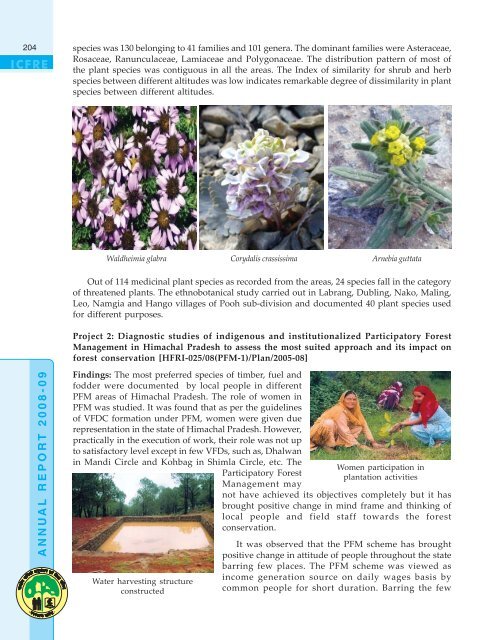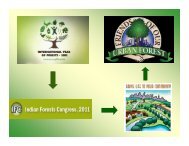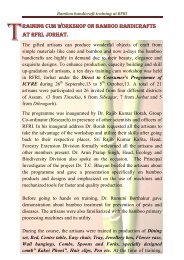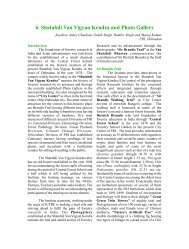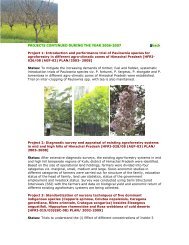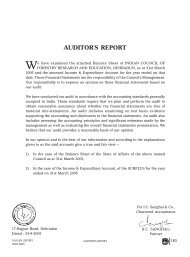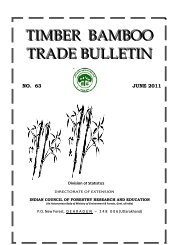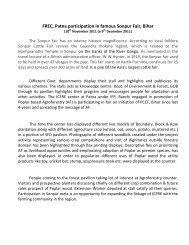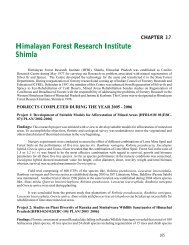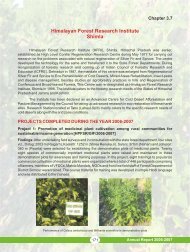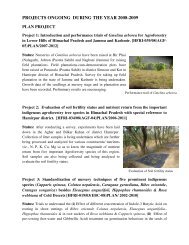Himalayan Forest Research Institute, Shimla - ICFRE
Himalayan Forest Research Institute, Shimla - ICFRE
Himalayan Forest Research Institute, Shimla - ICFRE
Create successful ePaper yourself
Turn your PDF publications into a flip-book with our unique Google optimized e-Paper software.
204 species was 130 belonging to 41 families and 101 genera. The dominant families were Asteraceae,<br />
Rosaceae, Ranunculaceae, Lamiaceae and Polygonaceae. The distribution pattern of most of<br />
the plant species was contiguous in all the areas. The Index of similarity for shrub and herb<br />
species between different altitudes was low indicates remarkable degree of dissimilarity in plant<br />
species between different altitudes.<br />
<strong>ICFRE</strong><br />
ANNUAL REPORT 2008-09<br />
Waldheimia glabra Corydalis crassissima Arnebia guttata<br />
Out of 114 medicinal plant species as recorded from the areas, 24 species fall in the category<br />
of threatened plants. The ethnobotanical study carried out in Labrang, Dubling, Nako, Maling,<br />
Leo, Namgia and Hango villages of Pooh sub-division and documented 40 plant species used<br />
for different purposes.<br />
Project 2: Diagnostic studies of indigenous and institutionalized Participatory <strong>Forest</strong><br />
Management in Himachal Pradesh to assess the most suited approach and its impact on<br />
forest conservation [HFRI-025/08(PFM-1)/Plan/2005-08]<br />
Findings: The most preferred species of timber, fuel and<br />
fodder were documented by local people in different<br />
PFM areas of Himachal Pradesh. The role of women in<br />
PFM was studied. It was found that as per the guidelines<br />
of VFDC formation under PFM, women were given due<br />
representation in the state of Himachal Pradesh. However,<br />
practically in the execution of work, their role was not up<br />
to satisfactory level except in few VFDs, such as, Dhalwan<br />
in Mandi Circle and Kohbag in <strong>Shimla</strong> Circle, etc. The<br />
Participatory <strong>Forest</strong><br />
Management may<br />
Water harvesting structure<br />
constructed<br />
Women participation in<br />
plantation activities<br />
not have achieved its objectives completely but it has<br />
brought positive change in mind frame and thinking of<br />
local people and field staff towards the forest<br />
conservation.<br />
It was observed that the PFM scheme has brought<br />
positive change in attitude of people throughout the state<br />
barring few places. The PFM scheme was viewed as<br />
income generation source on daily wages basis by<br />
common people for short duration. Barring the few


